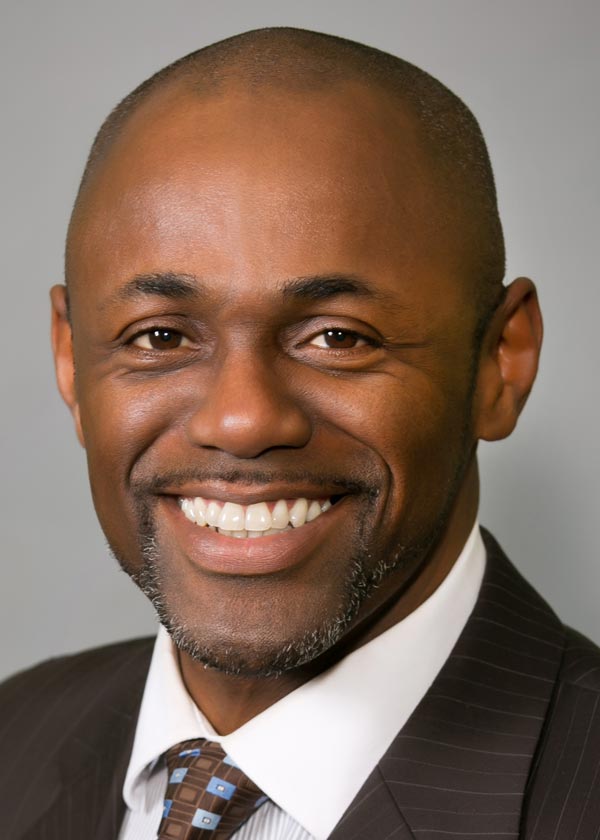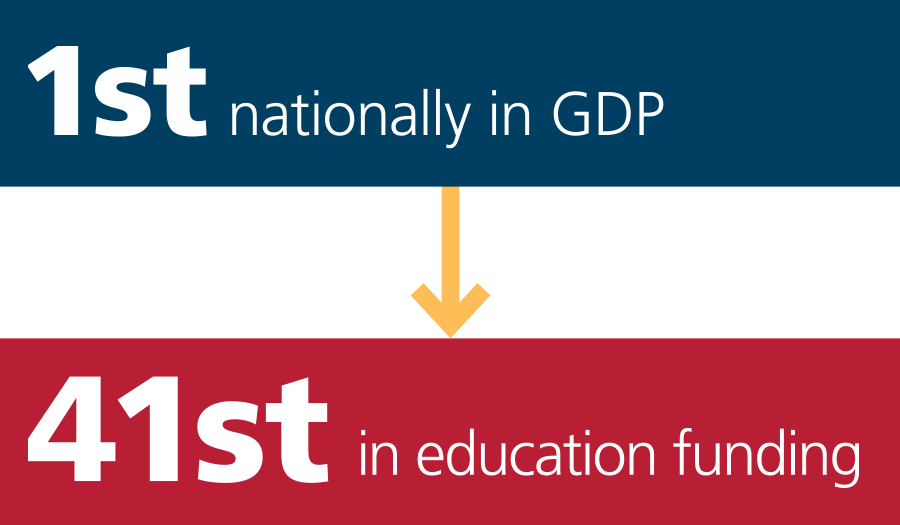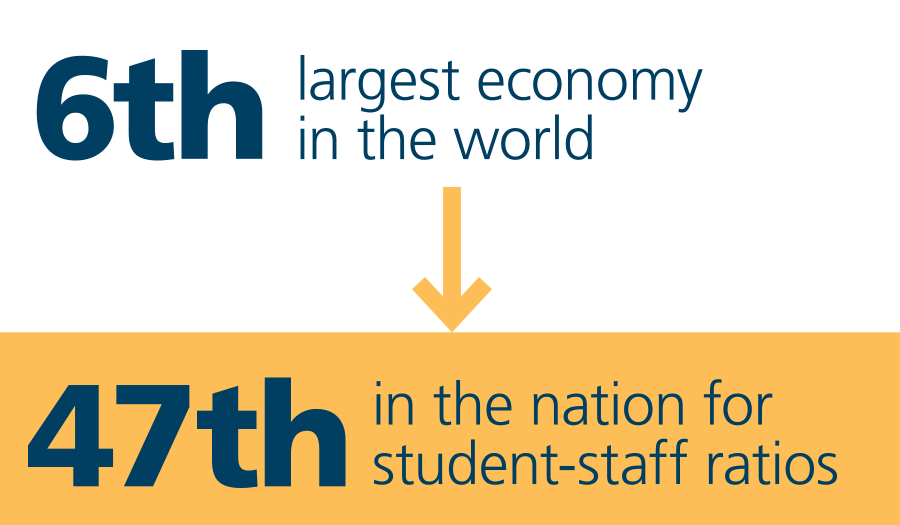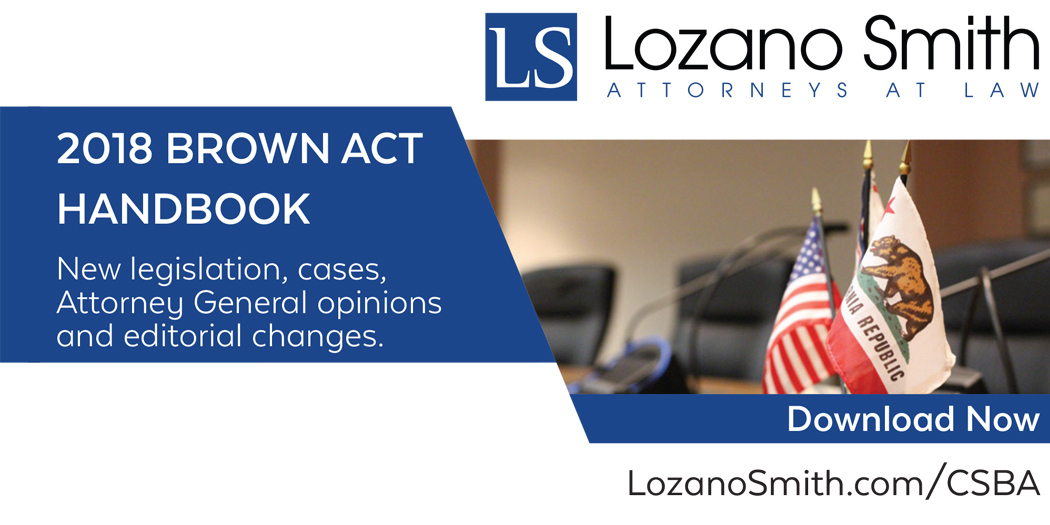

At present, approximately 90,000 African-American students do not generate LCFF supplemental and concentration grants, despite these students currently ranking as the lowest-performing group of students in the state.


- Visit www.csba.org/Newsroom for links to digital versions of current and past issues of California School News.

In California and many other states, public employees are required to pay their “fair share” or “agency fees” of union dues regardless of whether they choose to join the union or opt out — these fees are used for collective bargaining and contract administration, but not for unions’ political activities, which pay for lobbying and campaigning at the federal, state and local levels.

Troy Flint | tflint@csba.org
Managing Editor:
Kimberly Sellery | ksellery@csba.org
Marketing Director:
Serina Pruitt | spruitt@csba.org
Staff Writers and Contributors:
Hugh Biggar | hbiggar@csba.org
Aaron Davis | adavis@csba.org
Corrie Jacobs | cjacobs@csba.org
Graphic Design Manager:
Kerry Macklin | kmacklin@csba.org
Senior Graphic Designer:
Carmen Rodriguez | crodriguez@csba.org
Mike Walsh | Butte COE
President-elect:
Emma Turner | La Mesa-Spring Valley SD
Vice President:
Xilonin Cruz-Gonzalez | Azusa USD
Immediate Past President:
Susan Henry | Huntington Beach Union HSD
CEO & Executive Director:
Vernon M. Billy
News and feature items submitted for publication are edited for style and space as necessary.


We listened closely to what our hosts had to say. They talked about the successes their schools enjoyed and the obstacles they have encountered as they try to do more for their students. They also shared the opinion that CSBA must be careful to listen to all sides of an issue in order to represent all of its members and remain united in its mission to secure the highest outcomes possible for California’s 6.2 million public school students.



- Joel Ackerknecht, Board Member, Wasco Union HSD
- Dominique Ballante, Board Member, Keppel Union ESD
- Mary Barlow, Superintendent, Kern COE
- Ernie Bell, Superintendent, Sierra Sands USD
- Allison Bogart, Board Member, Kernville Union ESD
- Michele Bowers, Superintendent, Lancaster ESD
- Ty Bryson, Superintendent, Lakeside Union ESD
- Mayreen Burk, Board Member, Castaic Union SD
- Amy Castillo-Covert, Board President, Sierra Sands USD
- Daniel Enriquez, Board Member, Tulare City SD
- Carin Ezal, Board President, Goleta Union ESD
- Thomas Fairless, Board Member, Golden Plains USD
- Heather Fallis, Board Member, Lakeside Union ESD
- William Farris, Regional Director, Region 12, Sierra Sands USD
- Daniel Figueroa, Board Member, Burton ESD
- Juan Figueroa, Board President, Terra Bella Union ESD
- Tanya Fisher, Superintendent, Selma USD
- Monica Franks, Board Member, Earlimart ESD
- Vladimir Gomez, Board Member, Wilsona SD
- Jose Gonzalez, Board Member, Kern COE
- Victoria Green, Board Member, Wilsona SD
- Julie Greenwood, Board Member, Bass Lake Joint Union ESD
- Teresa Grey, Superintendent, Wilsona SD
- Fabiola Guerrero, Board Member, Woodville ESD
- Miguel Guerrero, Superintendent, Lamont ESD
- Robert Harris, Board President, Wilsona SD
- Irene Henderson, Board Member, Tulare City SD
- Candy Iribarren, Board President, Greenfield Union ESD
- Tim Johnson, Delegate, Region 12B, Sierra Sands USD
- Melinda Long, Board Member, Greenfield Union ESD
- Anne Misicka, Board Member, Wilsona SD
- Gregory Mudge, Board Member, Taft City SD
- Amy Nguyen-Hernandez, Superintendent, Adelanto ESD
- Sharon Nicol, Board Member, Wasco Union HSD
- Laura Pearson, Board President, Castaic Union SD
- Brian Penzel, Board President, Moreland SD
- Ruth Pichardo Harris, Board Member, Arvin Union SD
- Sandy Price, Board Member, Lancaster ESD
- Anna Rasmussen, Executive Assistant, Raisin City ESD
- Carolyn Ridge, Board Member, Delhi USD
- Kurt Rockwell, Board Member, Sierra Sands USD
- Efrain Rodriguez, Board President, Delano Union ESD
- Julia Sagaser Morris, Board Member, McKittrick ESD
- Yolanda Sanchez, Board President, Southern Kern USD
- Gaby Schmidt, Board President, Lakeside Union ESD
- Michael Scott, Board Member, Sierra Sands USD
- Mike Shaw, Board Member, Greenfield Union ESD
- Leo Sheridan, Board Member, San Leandro USD
- Russ Shuppert, Board Member, Bakersfield City ESD
- Evelyn Velasquez, Board Member, Lamont ESD
- Suzanne Villaruz, Board Member, Delano Union ESD
- Paul Wallace, Delegate, Region 8C, Newman-Crows Landing USD
- Jennifer Winter, Board President, Selma USD
- Ruben Zepeda II, Superintendent, Keppel Union ESD
- Joel Ackerknecht, Board Member, Wasco Union HSD
- Dominique Ballante, Board Member, Keppel Union ESD
- Mary Barlow, Superintendent, Kern COE
- Ernie Bell, Superintendent, Sierra Sands USD
- Allison Bogart, Board Member, Kernville Union ESD
- Michele Bowers, Superintendent, Lancaster ESD
- Ty Bryson, Superintendent, Lakeside Union ESD
- Mayreen Burk, Board Member, Castaic Union SD
- Amy Castillo-Covert, Board President, Sierra Sands USD
- Daniel Enriquez, Board Member, Tulare City SD
- Carin Ezal, Board President, Goleta Union ESD
- Thomas Fairless, Board Member, Golden Plains USD
- Heather Fallis, Board Member, Lakeside Union ESD
- William Farris, Regional Director, Region 12, Sierra Sands USD
- Daniel Figueroa, Board Member, Burton ESD
- Juan Figueroa, Board President, Terra Bella Union ESD
- Tanya Fisher, Superintendent, Selma USD
- Monica Franks, Board Member, Earlimart ESD
- Vladimir Gomez, Board Member, Wilsona SD
- Jose Gonzalez, Board Member, Kern COE
- Victoria Green, Board Member, Wilsona SD
- Julie Greenwood, Board Member, Bass Lake Joint Union ESD
- Teresa Grey, Superintendent, Wilsona SD
- Fabiola Guerrero, Board Member, Woodville ESD
- Miguel Guerrero, Superintendent, Lamont ESD
- Robert Harris, Board President, Wilsona SD
- Irene Henderson, Board Member, Tulare City SD
- Candy Iribarren, Board President, Greenfield Union ESD
- Tim Johnson, Delegate, Region 12B, Sierra Sands USD
- Melinda Long, Board Member, Greenfield Union ESD
- Anne Misicka, Board Member, Wilsona SD
- Gregory Mudge, Board Member, Taft City SD
- Amy Nguyen-Hernandez, Superintendent, Adelanto ESD
- Sharon Nicol, Board Member, Wasco Union HSD
- Laura Pearson, Board President, Castaic Union SD
- Brian Penzel, Board President, Moreland SD
- Ruth Pichardo Harris, Board Member, Arvin Union SD
- Sandy Price, Board Member, Lancaster ESD
- Anna Rasmussen, Executive Assistant, Raisin City ESD
- Carolyn Ridge, Board Member, Delhi USD
- Kurt Rockwell, Board Member, Sierra Sands USD
- Efrain Rodriguez, Board President, Delano Union ESD
- Julia Sagaser Morris, Board Member, McKittrick ESD
- Yolanda Sanchez, Board President, Southern Kern USD
- Gaby Schmidt, Board President, Lakeside Union ESD
- Michael Scott, Board Member, Sierra Sands USD
- Mike Shaw, Board Member, Greenfield Union ESD
- Leo Sheridan, Board Member, San Leandro USD
- Russ Shuppert, Board Member, Bakersfield City ESD
- Evelyn Velasquez, Board Member, Lamont ESD
- Suzanne Villaruz, Board Member, Delano Union ESD
- Paul Wallace, Delegate, Region 8C, Newman-Crows Landing USD
- Jennifer Winter, Board President, Selma USD
- Ruben Zepeda II, Superintendent, Keppel Union ESD
“It’s both comforting and inspiring to know that a native of California who is a longtime educator and passionate advocate for our public schools has been elected NSBA President,” added CSBA CEO & Executive Director Vernon M. Billy. “We look forward to bringing a California perspective to the national stage.”
To reconcile these points, the SBE’s plan includes the separate reporting of academic performance and change in academic performance over time. Additionally, 11th-grade standardized testing scores will be added to high school ratings.
Many districts have adopted CSBA Sample Bylaw 9400, which calls for an annual self-evaluation. CSBA’s Board Self-Evaluation Tool makes this process easy. Individual board members respond to specific questions related to good governance practice and board responsibilities, then the board discusses their cumulative answers in order to:
- Reflect on individual and collective behaviors and performance
- Identify strengths and weaknesses in board performance
- Hold the board accountable to itself, the staff and the community
- Improve communication and decision-making by enhancing a common understanding of goals, processes and current board protocols
- Provide a starting point for discussion of long-range goal setting and planning
The CSBA Board Self-Evaluation Tool compiles the answers into a report which highlights areas where board members have the greatest agreement, and areas that may need to be further examined.
- The report displays a range of perceptions, not facts.
- Focus your discussion on what matters most.
- Each member should practice empathetic listening and work to understand the views of other board members.
- It’s acceptable to differ in opinion; you don’t always need to agree, but you do need to try to understand.
- Focus on the most important areas for improving board performance by asking, “Which will be most beneficial to the board and the district?”
- Set specific, measurable goals for improving board performance in each area.
CSBA’s Governance Consulting Services provides board development coaching and guidance. If you would like more information about the Board Self-Evaluation Tool, please email us at bse@csba.org.


ast year, we embarked on one of the boldest ventures in our organization’s long and productive history. In response to a set of priorities identified by the Board of Directors, we began the process of transforming CSBA to meet the demands of a new era in public education. Those changes are now taking shape and CSBA is better positioned than ever to:
- Drive the education policy agenda to ensure high-quality education for every student by addressing adequacy and opportunity gaps
- Support local governing boards of education by increasing participation in CSBA board training programs
- Establish a robust grassroots system that can mobilize our members and maximize our political capital


n 2016, CSBA’s Board of Directors identified Full and Fair Funding for California schools — funding that provides the access, resources and supports needed to provide a high-quality education for all public school students — as a crucial need for California students and a priority for CSBA.





upporting trustee professional development and training is one of CSBA’s key strategic priorities. The CSBA Board of Directors is strengthening training programs by redesigning course content, developing a structured learning program, increasing accessibility and re-envisioning targeted marketing. The following is a summary of key areas we have worked on over the past year and will continue to build upon.
- In order to open more opportunities for CSBA members from small districts — defined as those with an average daily attendance of 2,500 or fewer — a Smalls Professional Learning Network has been created with funding from the California Collaborative on Educational Excellence. This network allows small district representatives from 15 local educational agencies from across the state to come together and obtain professional development while providing input on topics related to funding, the California School Dashboard, community engagement, Local Control and Accountability Plans and more — from the small-district perspective.


 If board members are not engaged and committed to this effort, then decisions about K-12 education in Sacramento will happen to you, and not because of you.
If board members are not engaged and committed to this effort, then decisions about K-12 education in Sacramento will happen to you, and not because of you. It truly encompasses the end goal of this strategic initiative: increasing CSBA member engagement in order to maximize our organization’s political strength. With local grassroots networks already being built and CSBA’s current package of sponsored legislation progressing through the Legislature (on the heels of this year’s well-attended Legislative Action Day), we’re already seeing that political strength grow as we reach the midway point of 2018.
For middle- and upper-class Americans, summer might entail family vacations, camps and local enrichment programs provided privately or by community-based organizations. However, for low-income families and children, it is typically a different story. For these children, summer is more likely an educational drought — a period when not only are they not learning anything new, but they are actually losing knowledge they gained during the school year.
Providing all students with more learning opportunities during the summer months is one of the most effective strategies to avoid summer learning loss and enhance student academic progress, according to researchers from the RAND Corporation. For example, one study of summer programs in third grade found that participation was associated with higher math and language arts achievement.
This month also provides school board members and others in the educational community with a reminder to review the demographic and achievement data of these diverse student groups in order to provide the support needed to ensure achievement for all students. While the California Department of Education reports data for Asian, Filipino and Pacific Islander students separately, districts and county offices of education should review disaggregated data, where available, to ensure that opportunity gaps are not masked. For example, while the achievement of Asian students might be high overall, these students include Cambodian, Laotian and Hmong students, who have been historically underserved.
For the estimated 250,000 undocumented children between the ages of 3 and 17 who are enrolled in California public schools, the 750,000 K-12 students in California who have an undocumented parent and the 5,000 undocumented teachers who reside here, nothing is certain when it comes to immigration.
Beginning as a single presentation to 30 people in Banning, Calif., 10 years ago, the initiative has grown to become a countywide effort. In partnership with community organizations and businesses, the strategy includes outreach, intervention programs and support services.
May Delegate Assembly
Leadership Institute
MIG Courses
MIG Courses
MIG Course 3
MIG Courses






